Alexandria, a strip of land between desert and sea. This city of 4 million people hemmed in by Lake Mareotis to the south and the Mediterranean to the north.

The Cornish, Le Corniche, El-Geish Road.
The seaside road. It starts in the west at the Qait Bey fortress (former site of the ancient Pharos lighthouse) and unravels over the course of about 20 miles. It is the elongated center of the city. Here the force of the city comes to a halt. Here begins the territory of the marine archaeologists. Here young couples find refuge below the rocks and official condemnations of such behavior are written in formal script on the pylons.

Gaining Power over the Water
If you say to taxi drivers that you are studying archeology they laugh and say over and over “dahab dahab dahab”…gold gold gold. The underwater archaeological sites in the harbor are divided into three zones: one for the French entrepreneur, one for the Greek-Alexandrian with an unfinished dissertation on the tomb of Alexander the Great and one zone for the French scholar. There are no permits for an Egyptian mission. A large stretch of the harbor to the west of Qait Bey Citadel is a military zone. These waters are off limits to everyone except for the few local divers who are friends with the soldiers.
Qait Bey Citadel
My first glimpse of the former site of the Pharos lighthouse, where Qait Bey citadel now stands, was a sideways glance while hopping into a mini-van: the most efficient and cheapest way to get around. My second day we stop short of the goal—a young sailor picks up a conversation with us as we are walking on the Corniche. He takes us out for ice cream near the lighthouse site. The walls of the ice cream parlor are lined with the pixelated photographs of young people killed in the revolution, illuminated by light-boxes. By the time we are done it is sunset and the citadel is closed.

On the third day we enter the citadel. Understanding the geology of the building materials is often the only guide to piecing together the past. By reading the surface of the fort one finds incongruous bits of red granite wedged into the white limestone building: these are stones from the ancient lighthouse, one of the ancient wonders of the world. In an alcove are some of the remnants, unmarked.
A model inside the fort shows what it looked like before British bombardment. What’s missing now: a soaring minaret, once the tallest mosque in the world.
A Hole to See the Past Through (Mosque el-Nabi Daniel)
Sharia Mataba is the site of the new Library of Alexandria, translated as “Bookshop Street” in English on the street sign. This would be a more appropriate title for Sharia el-Nabi Daniel (Street of the Prophet Daniel), the ancient north-south running street today lined with stalls of book vendors. Originally called by the Greeks Soma, or the road of the body.
Alexandria is one of the few places in Egypt where the modern city is built directly on top of the ancient one. The high-rises are slanting as the weak limestone foundation of the new city sags under the exorbitant weight. In front of the Mosque el-Nabi Daniel is a massive cavity in the ground from the removal of a collapsed building. Archaeologists hope to obtain the permits to dig here before a new building takes its place. In a city with a constant need to house its soaring population, archaeologists are lucky if they even get a permit to do salvage excavations before the site vanishes forever. As European archaeological missions are trying to piece together the remains of Alexandria’s Greco-Roman past, cynics say that since the discoveries are not related to the Islamic history of the city, there is little public interest in saving it.

As the 19th century buildings are being demolished, they are replaced with tower blocks and basement garages that slice through all the archaeological layers. Whereas the foundations of the older buildings were lighter and shallower and instead of destroying the archaeological layer these buildings did quite the opposite: sealing and preserving time. People stop to watch us photograph from the precipice of the cavity. I assume it is because we are foreigners photographing trash and rubble. Sometimes people will dissuade us from photographing debris or they will say no outright, like when my companion tries to photograph a discarded campaign poster for the Muslim Brotherhood with the two candidates eyes’ poked out. But as we stand in front of this gaping hole we are joined by people who point down to it as well.

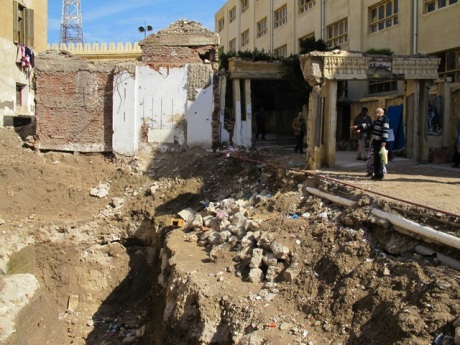
A typical Egyptian joke: whenever there is a construction site in the city a passerby will look down into the hole and say to the workers, “Hey did you find Alexander the Great?”
Behind this cavity is the Mosque el-Nabi Daniel which houses a famous rumor: the location of the tomb of Alexander the Great. One of the most famous proponents of this theory was Heinrich Schliemann who, after rediscovering the remains of Troy, came to Alexandria with the intentions of finding the tomb of the city’s founder. And indeed upon entering we are lead to a recessed room where slender Greek corinthian columns meld into the mixture of sheetrock and marble of the present-day building. From this room lacquered wooden stairs lead to an underground chamber of vaulted ceilings and Roman arches. A small hole leads straight into blackness. My companion, in a combination of Arabic and pantomime, asks if anyone has ever crawled through the hole. A response comes in a gesture that mimics the effect of climbing down and suffocating to death.
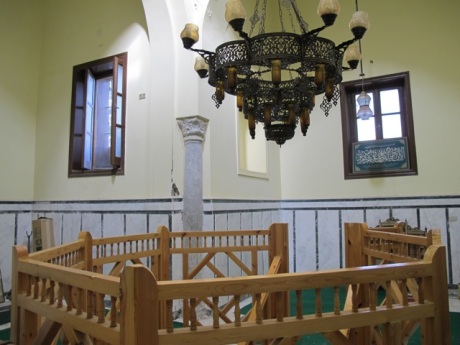

The location of the tomb of Alexander still eludes archaeologists, and the Graeco-Roman Museum counts 139 attempts over the past century to rediscover it—including a Greek waiter who for three decades held up traffic in his spare time as he dug in the streets looking for the tomb. Nowadays, archaeologists are looking further to the east of the city in the present-day Roman-Catholic cemetery. As finding the body of Alexander becomes one of the holy grails for archaeologists and the uncertainty of whether the Prophet Daniel is even buried at the mosque to which he lends his name (he is thought to be buried in many places), we can make a list of scattered holy bodies that spans Egypt’s civilizations: Osiris, Alexander, Saint Mark, Prophet Daniel.
Across from the Mosque el-Nabi Daniel is Alwafai mosque. We crane our heads to see in the courtyard a lone roman column like a decapitated tree.
KOM EL-DIKKA
Here at Kom el-Dikka, The Mound of Rubble, is a Greco-Roman lecture hall and stadium with mosaics, theaters and graffiti praising Greek chariot warriors scratched into the walls. Standing on the ancient ground of the city you can crane your neck high to see the foundation of the present city with a cross section of red brick foundation of the Byzantine period sandwiched between the two.

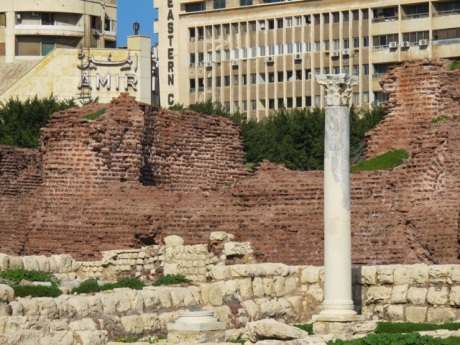
Lining the excavation crater is an avenue of artifacts pulled up from waters; the submerged ancient city and Pharos lighthouse. 26 pieces are on display here: sphinxes of coarse pinkish granite, dark grey granodiorites, yellowish siliceous sandstone, dark greywacke and white marble. A white stone fragment with its accompanying informational panel is fortuitously still in place. It reads: this could very well be part of the inscription from the lighthouse because within the hollows of the letters are fixing holes for the incrustation of metal letters, confirming descriptions made by early Arab travelers. This small fragment of 115 x 100 x 26 cm weighs an astounding 41 tons.
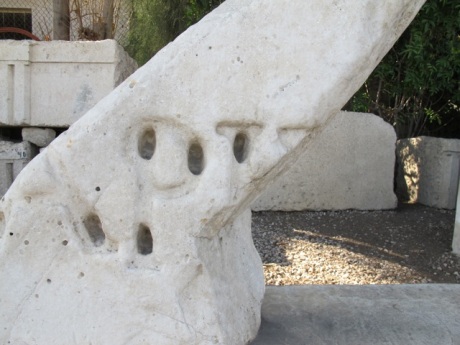

Archaeology and speculation. Fictional recreations. The infamous ‘door’ of Cleopatra’s submerged palace stands under a street lamp in Kom el-Dikka. It was pulled from the water by the Greek excavation. My companion is skeptical: “a door for lilliputians, perhaps.”





















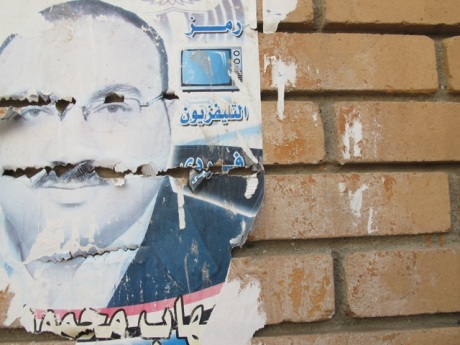















You must be logged in to post a comment.